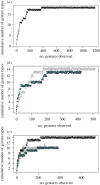The social dynamics of complex gestural communication in great and lesser apes (Pan troglodytes, Pongo abelii, Symphalangus syndactylus)
- PMID: 35934967
- PMCID: PMC9358312
- DOI: 10.1098/rstb.2021.0299
The social dynamics of complex gestural communication in great and lesser apes (Pan troglodytes, Pongo abelii, Symphalangus syndactylus)
Abstract
Gestures play an essential role in primate communication. However, little is known about how complexity of gestural use (in terms of repertoire size, intentional use, flexibility and use of gestural sequences) relates to individual and dyadic measures of sociality and whether more complex gestural use is more effective in eliciting a response. We observed 19 captive chimpanzees (Pan troglodytes), 16 Sumatran orangutans (Pongo abelii) and 18 siamangs (Symphalangus syndactylus) to assess the complexity and effectiveness of their gestural use. We found that, beyond interspecies variation, the number of gesture types used in a dyad was higher when individuals had stronger social bonds; the probability of accounting for others' attention increased with age, especially for visual gestures; and sequences were more likely used by younger or socially less integrated individuals. In terms of effectiveness, older individuals and those using fewer sequences were more likely to be responded to, while across dyads, the probability of obtaining a response was higher when both individuals accounted for the other's attention and when they used fewer sequences. Overall, this confirms the link between sociality and complex gestural use and suggests that more complex forms of communication, at least in terms of intentional use, may be more effective at achieving communicative goals. This article is part of the theme issue 'Cognition, communication and social bonds in primates'.
Keywords: chimpanzees; complex gesture use; orangutans; siamangs; sociality.
Conflict of interest statement
We declare we have no competing interests.
Figures


Similar articles
-
Gestural repertoire size is associated with social proximity measures in wild chimpanzees.Am J Primatol. 2019 Mar;81(3):e22954. doi: 10.1002/ajp.22954. Epub 2019 Feb 1. Am J Primatol. 2019. PMID: 30706956
-
Visual attention, indicative gestures, and calls accompanying gestural communication are associated with sociality in wild chimpanzees (Pan troglodytes schweinfurthii).J Comp Psychol. 2019 Feb;133(1):56-71. doi: 10.1037/com0000128. Epub 2018 Aug 16. J Comp Psychol. 2019. PMID: 30113179
-
Persistence in gestural communication predicts sociality in wild chimpanzees.Anim Cogn. 2019 Sep;22(5):605-618. doi: 10.1007/s10071-018-1219-6. Epub 2018 Oct 19. Anim Cogn. 2019. PMID: 30338419 Free PMC article.
-
Are ape gestures like words? Outstanding issues in detecting similarities and differences between human language and ape gesture.Philos Trans R Soc Lond B Biol Sci. 2022 Sep 26;377(1860):20210301. doi: 10.1098/rstb.2021.0301. Epub 2022 Aug 8. Philos Trans R Soc Lond B Biol Sci. 2022. PMID: 35934962 Free PMC article. Review.
-
Looking in apes as a source of human pathogens.Microb Pathog. 2014 Dec;77:149-54. doi: 10.1016/j.micpath.2014.09.003. Epub 2014 Sep 16. Microb Pathog. 2014. PMID: 25220240 Review.
Cited by
-
Communicative roots of complex sociality and cognition: preface to the theme issue.Philos Trans R Soc Lond B Biol Sci. 2022 Sep 26;377(1860):20220115. doi: 10.1098/rstb.2022.0115. Epub 2022 Aug 8. Philos Trans R Soc Lond B Biol Sci. 2022. PMID: 35934965 Free PMC article.
-
Idiosyncratic gesture use in a mother-infant dyad in chimpanzees (Pan troglodytes schweinfurthii) in the wild.Anim Cogn. 2024 Oct 3;27(1):64. doi: 10.1007/s10071-024-01904-3. Anim Cogn. 2024. PMID: 39363126 Free PMC article.
-
Wild and captive immature orangutans differ in their non-vocal communication with others, but not with their mothers.Behav Ecol Sociobiol. 2024;78(1):12. doi: 10.1007/s00265-023-03426-3. Epub 2024 Jan 15. Behav Ecol Sociobiol. 2024. PMID: 38235053 Free PMC article.
-
Social negotiation and "accents" in Western lowland gorillas' gestural communication.Sci Rep. 2024 Oct 28;14(1):25699. doi: 10.1038/s41598-024-75238-y. Sci Rep. 2024. PMID: 39465246 Free PMC article.
-
Age differences in bonobo (Pan paniscus) multimodal communication signals.Anim Cogn. 2025 May 19;28(1):38. doi: 10.1007/s10071-025-01961-2. Anim Cogn. 2025. PMID: 40387940 Free PMC article.
References
-
- Liebal K, Müller C, Pika S. 2007. Gestural communication in nonhuman and human primates. Amsterdam, The Netherlands: John Benjamins Publishing Company.
-
- Call J, Tomasello M (eds). 2007. The gestural communication of apes and monkeys. New York, NY: Lawrence Erlbaum Associates.
-
- Pika S, Liebal K. 2012. Developments in primate gesture research. Amsterdam, The Netherlands: John Benjamins Publishing Company.
MeSH terms
LinkOut - more resources
Full Text Sources

